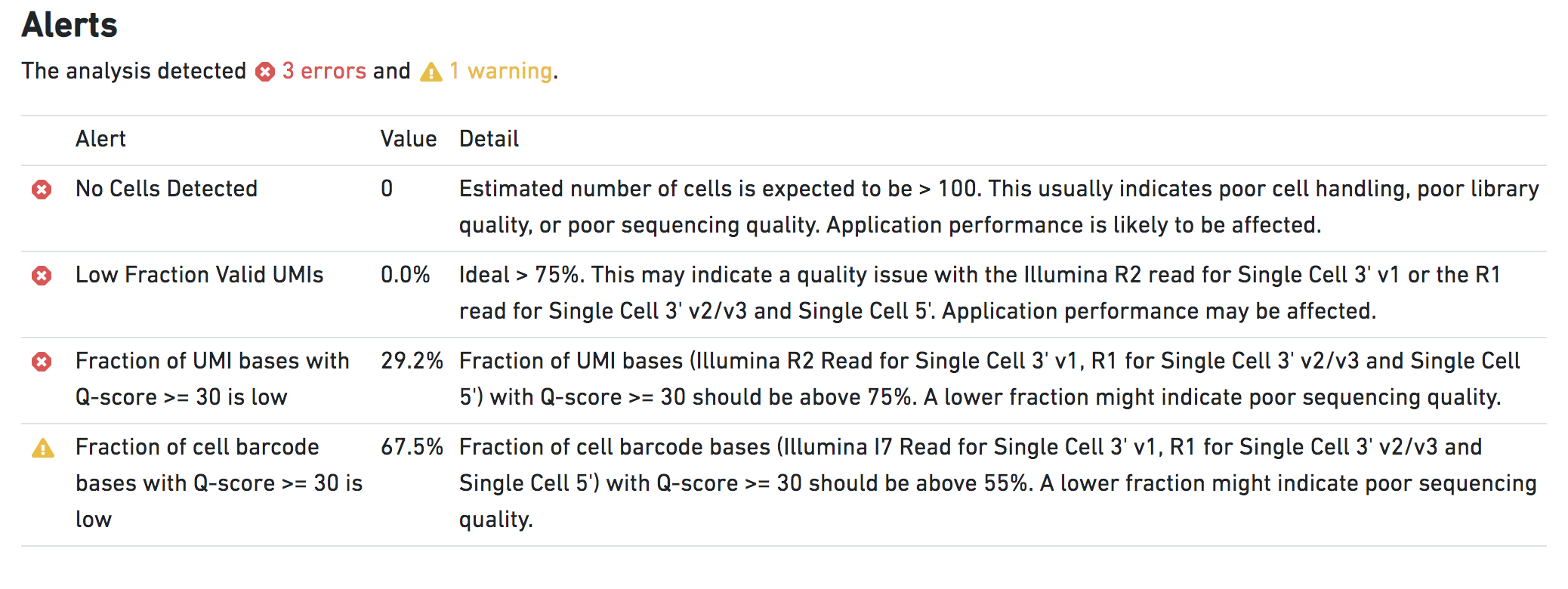10x Genomics
Chromium Single Cell Gene Expression
Cell Ranger7.1 (latest), printed on 07/12/2025
Troubleshooting Cell Ranger
When the cellranger pipelines fail, they will automatically generate a "debug tarball" that contains the logs and metadata generated by the pipestance leading up to failure. This file, named sample_id.mri.tgz, can be e-mailed to the 10x Genomics software team to help resolve any issues with using Cell Ranger.
You may also use the cellranger upload command to send the tarball to 10x Genomics. Customize the code in red with your email and sample_id.mri.tgz:
$ cellranger upload your@email.edu sample_id.mri.tgz
If you wish to troubleshoot a pipeline failure yourself, it is important to identify if you are experiencing a preflight failure, an in-flight failure, or an alert.
| The remainder of this guide uses the term pipestance to refer to a specific instance of a pipeline running. |
Preflight failures
Preflight failures are the most common and are the result of invalid input data or runtime parameters. Because they occur before the pipeline actually runs, there will be no pipeline output and the error is reported directly to your terminal.
A common preflight failures occurs when bcl2fastq has not been installed. The cellranger mkfastq pipeline will generate the following error if Illumina's bcl2fastq software is not installed:
[error] On machine: workstation.university.edu, bcl2fastq or configureBclToFastq.pl not found on PATH.
In-flight failures
In-flight failures are generally the result of factors external to the pipeline such as running out of system memory or disk space. Different stages may fail in different ways so the specific error messages vary widely.
Finding relevant error logs
There are a few important files that are saved to your pipeline output directory which, by
default, is named according to the flow cell ID for cellranger mkfastq
(e.g., HAWT7ADXX) and your --id name for cellranger count or multi.
-
The pipeline execution log that is output to your terminal during pipeline execution is also saved to
output_dir/_log. -
Stages that experience a hard failure generate an
_errorsfile containing the precise error that caused a stage to halt. You view these error logs, if they exist, using
find output_dir -name _errors | xargs cat
- Each stage also logs its stdout and stderr streams to
_stderrand_stdoutfiles. These logs can be listed using
find output_dir -name _stderr
The _stderr and _stdout may contain elucidating error messages in stages that execute third-party applications such as STAR.
A more detailed description of the pipeline output directory and its contents is given in the Pipestance Structure page.
| If you are unable to diagnose a failure yourself, you can always contact the 10x Genomics software support team for help. |
Resuming a failed pipestance
Once you have determined the reason for failure and are ready to continue running the pipeline, you can typically issue the same cellranger command to continue execution of the pipestance from the stage that originally failed.
At the start of any cellranger pipeline, the software looks for its intended output directory. If such a directory exists, this directory/run is treated as an incomplete pipestance and cellranger resumes pipeline execution. While this feature allows cellranger pipelines to be stopped and resumed with great flexibility, it can also result in errors such as:
RuntimeError: /home/jdoe/runs/sample345 is not a pipestance directory
which indicates that you specified an --id that corresponds to an existing directory that was not created by Cell Ranger.
The following error:
RuntimeError: pipestance 'HAWT7ADXX' already exists and is locked by another Martian instance. If you are sure no other Martian instance is running, delete the _lock file in /home/jdoe/runs/HAWT7ADXX and start Martian again.
indicates that you may already have a copy of cellranger running that is using the same output directory. If you are sure that there is no pipestance running in the given output directory, you can either remove that output directory entirely (mv HAWT7ADXX HAWT7ADXX.old) to restart the pipestance from the beginning, or you can remove the pipestance's lock file (rm HAWT7ADXX/_lock) and re-run the cellranger command to resume pipeline execution.
If you encounter the following error when attempting to resume a pipestance:
RuntimeError: pipestance 'sample345' already exists with different invocation file /home/jdoe/runs/sample345/_invocation
you are attempting to resume a pipestance using command-line arguments that are different from those used to first run it. You can view the input parameters to the existing pipeline by examining the _log file located in the output directory (e.g., head -n20 /home/jdoe/runs/sample345/_log).
Note that for cellranger multi, any changes to the multi config CSV file (e.g., editing file paths) alters the inputs and Cell Ranger will not be able to resume the failed pipestance with the same command. You will need to either specify a new --id in the command or delete the failed output directory, before re-running the command.
Alerts
Alerts are generally the result of factors inherent in library preparation and sequencing instead of software. Abnormal data (including common short-read sequencing metrics and Chromium-specific statistics) are raised in the form of alerts that are printed in the output web_summary.html file. Alerts do not affect the operation of the pipeline, but they do highlight potential causes for abnormal or missing data.
Alerts come in two severity levels:
-
WARNING alerts indicate that some parameter is suboptimal, but there may still be useful data in the pipeline output.
-
ERROR alerts indicate a major issue, and there is unlikely to usable results in the output.
For example, running cellranger on a human sample with a human and mouse reference will likely result in an alert indicating low read alignment quality:

These WARNING alerts are not indicative of a lost sequencing run, and re-running cellranger with the proper human reference would likely not return this alert.
Poorly constructed libraries typically display more severe ERROR alerts. For example, a low-quality library may result in the following alerts:

The presence of these ERROR alerts indicate that results that are output by this pipestance are likely dubious.